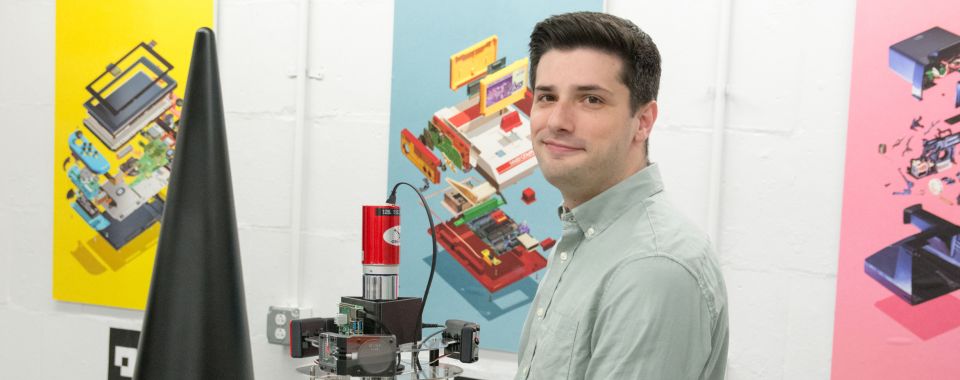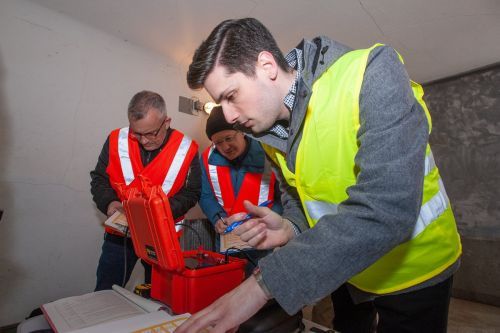
Eric Lepowsky has combined expertise in robotics and nuclear arms control to create a robotic system that strategically does not record sensitive information, making it more likely that skeptical state actors would participate in an inspections process. Photo by Michael FrankenBy Sharon Waters
Office of Engineering Communications
In the high-stakes world of nuclear arms control, a Princeton doctoral student is exploring how robots can make nuclear inspections more accurate and more acceptable to host nations that may be wary of invasive conventional methods.
Eric Lepowsky, a fifth-year Ph.D. candidate in the Department of Mechanical and Aerospace Engineering, applies concepts from robotics to nuclear safeguards to develop novel inspection and verification techniques.
His latest research has led to a robot that can perform inspections without saving sensitive information, making inspections less invasive.
“In a real-life scenario, the host nation likely won't want a human inspector sort of poking their nose around. And that's where there's a benefit to having a robot instead. But even a robot has memory, and a robot has a full suite of sensors that's acquiring data,” said Lepowsky.
The goal is to have a high-confidence inspection without the robot saving information. For example, the robot would not save radiation measurements. Or perhaps the room to be searched is so sensitive that a floor plan does not exist, and the host will not want a floor plan to be created by the robot.
The new prototype is built on an iRobot Create 3 platform, an educational robot from the makers of Roomba vacuums. “When you look at it, it looks identical to a Roomba, but if you turn it upside down, you'll be disappointed when there's no vacuum. You can't clean your floors with this one.”
Robots offer advantages over human inspectors. Robots can tolerate higher radiation levels, are more consistent, don’t get fatigued and can be cheaper. They also can be programmed to generate a degree of trust – don’t put a camera on the robot and it won’t see what you don’t want it to see, for example.
The project’s biggest obstacle was self-imposed, according to Lepowsky. With most approaches to robotic radiation detection, users either start with a map of the space or use sophisticated algorithms to generate a map as they go. Lepowsky teamed up with fellow MAE graduate student David Snyder, from Anirudha Majumdar’s Intelligent Robot Motion Lab, to tackle this problem.
The new robot builds on concepts from a neutron-detecting robot created in collaboration with the Princeton Plasma Physics Laboratory and Robert J. Goldston, professor of astrophysical sciences. But instead of neutron detectors, the new robot uses gamma detectors. Neutron detectors can assess if an object contains plutonium, which emits a lot of neutrons. Gamma detectors can be better for confirming an object is not a uranium-based weapon component either – a lesson learned during an international verification experiment in which Lepowsky participated earlier this year.
The idea for the latest robot started with Lepowsky’s adviser, Alex Glaser, associate professor of mechanical and aerospace engineering and international affairs, who got curious about creating a “forgetful robot” that could perform a highly accurate nuclear arms inspection but forget everything afterward. That line of questioning led to an even more interesting proposition.
“Rather than forgetting,” Lepowsky said, “we're not even remembering in the first place.”
Lepowsky believes this feature can appease a host that is concerned about privacy.
Glaser said Lepowsky’s tenacity has played a key role in his success. Referencing Steven Levy’s book “Hackers: Heroes of the Computer Revolution,” he said: “There are many problems in the world that can really be solved by applying twice the persistence that other people will.” Glaser added: “Eric is one of these researchers who fall into this category, and it has been amazing to see what he has accomplished as part of his Ph.D. work over the past few years here at Princeton.”
Lepowsky likes the interdisciplinary nature of his work — drawing on his robotics expertise as a mechanical engineer and on his policy expertise as part of the Program on Science and Global Security within the School of Public and International Affairs — and he likes that it requires a breadth of knowledge, not just depth. He also relishes that his research is grounded in a real-life application for global security and nuclear nonproliferation.
But predicting when the robot might be used in the field, in a host country, is difficult.

“It's easy to say, today, it’s not very realistic, but you have to be ready for if and when it becomes feasible,” said Lepowsky. Research into this problem is very active, he said. Because arms control is in a state of flux, the specific objectives of future agreements is very difficult to predict. “But we can hope that they will be positive, and we need to be ready, on a technical side, to support the politics and international policy, when that moves in a favorable direction.”
Prior to joining Princeton, Lepowsky graduated from the University of Connecticut with a bachelor’s degree in mechanical engineering. He previously researched biotechnology — including microfluidics, 3D printing and point-of-care diagnostics — before interning at the MIT Lincoln Laboratory, which sparked his interest in applied physics, emerging technologies and security.
He is a National Science Foundation Graduate Research Fellow.